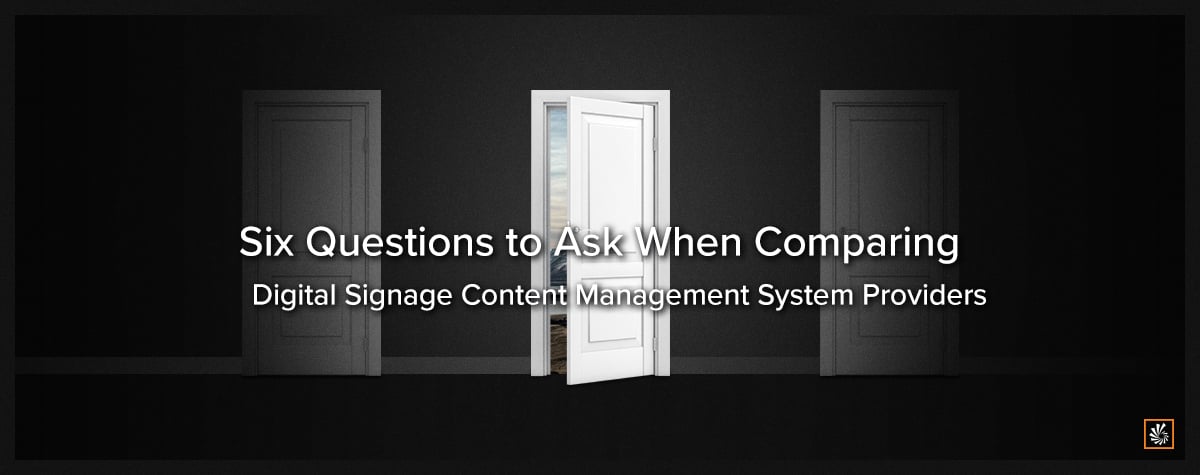What Is a Digital Signage Content Management System?
Any company that maintains a decent online presence these days is familiar with the idea of content management. According to Wikipedia’s simplistic definition, content management is “a set of processes and technologies that supports the collection, managing, and publishing of information in any form or medium.” The technology portion—that is, the software—is usually referred to as a content management system or CMS. While content management allows organizations to manage internal documents efficiently, today content management usually refers to website content presented to visitors. Whether this content is webpages, images, videos, or downloadable assets, its purpose (should) be to heighten engagement, whether the audience is customers, prospective customers, employees, or whomever else may be visiting.
Content Management System, or CMS, is also used to describe the technology used to deliver content in a digital signage network. However, a website and a digital signage network aren’t the same. They serve different marketing needs, and they reach audiences differently. Digital screens can catch and hold the attention of customers strolling through a retail store. Or they can aid in corporate communications and employee engagement, especially for deskless workers who don’t have a dedicated computer, company intranet access, or corporate email. Digital screens can indeed display the same type of content files as a website. But, unlike a website, the digital content experiences made possible by digital signage require scheduling, tagging, monitoring, and deployment across a vast network of digital display devices. That’s why the content management systems needed to manage each to be different.
So, just what is a digital signage content management system?
The basics of a digital signage content management system
Any CMS has to allow an organization to collect, manage, and publish its content. A digital signage CMS must also allow you to schedule content pushes to multiple digital screens and players. Visitors to a website all have much the same experience, discounting a certain amount of personalization for return visitors. However, the various screens in a digital signage network serve different audiences and purposes, which means content distribution has to be smarter and more sophisticated.
Take a retailer with stores dispersed across a wide geographical area, each with dozens or hundreds of digital screens. These businesses require content experiences that vary from location to location, department to department, and from day to day—even from minute to minute. Because of the wide variety of audiences and screen locations, a must allow for the tagging of content to indicate its appropriateness for individual audiences. And a comprehensive digital signage CMS provides tools to create playlists and customized experiences without switching between a plethora of authoring tools.
Going beyond the basics of a digital signage CMS
Organizations with more than a handful of local digital screens need a digital signage CMS that goes beyond the basic capabilities of content creation, playlists, and scheduling. The CMS should monitor each screen or player’s health and allow staff to troubleshoot and resolve problems remotely. It should help optimize network bandwidth so as not to impact the performance of other operational systems. It must integrate with (and leverage the data from) existing enterprise systems, internal and external content sources, and third-party solutions. And organizations need their CMS to help them analyze their digital signage content’s effectiveness to enable better decisions and optimize performance.
Finally, any sizable company that leverages digital signage requires a digital signage content management system that will scale as the network grows to hundreds or thousands of devices or even more.
Organizations with more than a handful of local digital screens need a CMS that goes beyond the basic capabilities of content creation, playlists, and scheduling. They need a digital signage content management platform, one that can monitor each screen or player’s health and allow staff to troubleshoot and resolve problems remotely. One that can optimize network bandwidth so as not to impact the performance of other operational systems. One that readily integrates with (and leverage the data from) existing enterprise systems, internal and external content sources, and third-party solutions. And organizations need their content management platform to help them analyze their digital signage content’s effectiveness to enable better decisions and optimize performance.
Visit our ReflectView product page to see how ReflectView's capabilities go far beyond your basic CMS.
Share this
You May Also Like
These Related Stories

Digital Signage Content Management System or Content Creation?

What is Your Digital Signage Content Management Plan?


